Bridging C# and C++ on Unix
Unlike Microsoft's .NET, Mono lacks a C++ compiler that can generate CIL code or mixed CIL/native code. This makes it harder for C++ codebases to integrate with C# code.
One solution to the problem is to write C wrappers for every C++ method and then use P/Invoke to call into each wrapper. Dealing with virtual methods then becomes challenging.
Andreia Gaita explains on Binding C++ APIs a technique that can be used to bridge the C++ and C# worlds using Mono's built-in support for COM objects.
Posted on 03 Aug 2009
SUSE Studio is out - The Linux Appliance Builder
Update: Nat Friedman has written two great blog posts on SUSE Studio, check them out here:
 Today Novell announced the release
of Nat's latest
project: SUSE Studio. Nat
has been working on this for a very long time.
Today Novell announced the release
of Nat's latest
project: SUSE Studio. Nat
has been working on this for a very long time.
Studio is a tool that allows anyone with a web browser to create Linux-based systems and appliances. We believe that this is one of Linux' major strengths and we wanted to turn this potential into a reality.
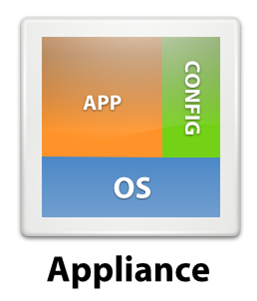 In addition to custom Linux builds, Nat's team has put a
strong focus on Linux-based appliances.
In addition to custom Linux builds, Nat's team has put a
strong focus on Linux-based appliances.
The goal of an appliance is:
- Perform a single task well.
- Requires minimal assembly and setup.
- It comes as a standalone unit.
The idea is that software developers can combine into a single deployable unit (a) the operating system; (b) your software plus any dependencies requires; (c) the proper configuration and data files required to operate.
When you build your appliance with Studio, you can select the kind of system you want, the packages you want to install, you can preconfigure the system and you can even test-drive the result over the web (it uses a Flash applet) and even fine tune or do some last minute touches over the web (inside the Flash applet) before producing your final version:
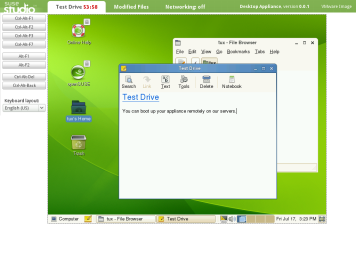
Test your Linux over the web.
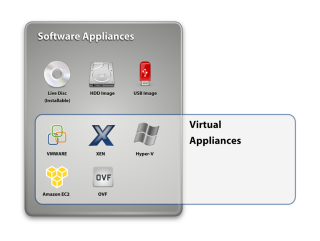 The resulting Linux distribution can be downloaded as an
ISO image, you can update it, you can create a bootable USB
Linux system with your software, generate a VMWare image or
VPC image and next week you should be able to deploy them in
Amazon EC2.
The resulting Linux distribution can be downloaded as an
ISO image, you can update it, you can create a bootable USB
Linux system with your software, generate a VMWare image or
VPC image and next week you should be able to deploy them in
Amazon EC2.
We have been using Studio for building the Mono downloaded VMware/VPC images for a while. We bundle the latest Mono, MonoDevelop and various ASP.NET and Windows.Forms samples for developers to try out.
As a software developer, you can move from a world where you let the end users assemble the solution themselves:

Into a setup where you deliver the entire package to your end user:
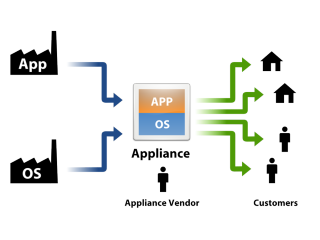
The above scenario is common in the Linux world, non-existent in the OSX world, and only large OEMs are able to do the same on the Windows world.
What we wanted to do was enable anyone, with little Linux expertise to setup their own operating systems. You do not have to be an expert on kernels, boot loading, dependencies or anything else to produce your own operating system.
In addition to Unix software, we are going to make it very easy for Windows developers to bring their applications to Linux. Our Mono for Visual Studio project will now allow developers to go straight from Visual Studio into a Linux powered appliance:
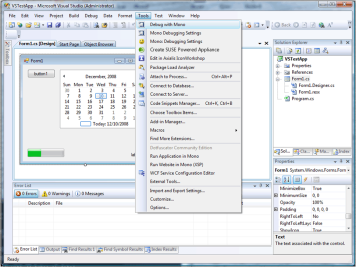
Mono Visual Studio Plugin allows .NET to Appliance compilation.
Posted on 28 Jul 2009
Proposed C# extensions
Scott Peterson has written a proposal to extend C# to support parameterless anonymous methods.
Scott's proposal includes a patch for Mono's C# compiler that implements the suggestion.
The short story is that with this patch allows constructor initializers to also initialize events in an object. So you can now write code like this:
var button = new Button () {
Label = "Push Me",
Relief = ReliefStyle.None,
Clicked +=> Console.WriteLine ("ouch!")
};
Both Bockover and myself love the 3.0 initializer syntax for objects and the only place where the awesomeness broke was the event initialization.
Posted on 27 Jul 2009
Improving Mono's compatibility with .NET CLR
For as long as we remember, most new versions of IronPython, IronRuby or the Dynamic Language Runtime exposed new missing functionality in Mono.
After a major release of any of these tools that deeply exercise the internal Reflection.Emit support and the runtime we would implement the missing features and ship a new Mono version.
As part of the Microsoft/Novell collaboration on Silverlight for Linux, a couple of months ago, we received from Microsoft the test suite for the Silverlight class libraries.
We have been working on fixing all of the issues exposed by the test suite. The test suite exposed bugs in Mono and missing features that are necessary for Silverlight in general, as well as the DLR and the DLR-based languages like IronRuby and IronPython.
We are pretty excited about the progress and the increased compatibility of Mono with Microsoft's .NET.
Posted on 27 Jul 2009
MonoDevelop Refactoring
The other day I did a quick tweet-vey asking folks what they wanted to see in MonoDevelop the most. It turned out that what they wanted the most matched pretty much what we had been working on.
About 50% of the features requested will be in our upcoming MonoDevelop 2.2. One cool refactoring tool is bound to the F2 key. You press F2 in a parameter or local variable, and as you edit the local/variable, all the references in your method are updated accordingly live.
ObScreenshot:

There are many more features on the pipeline, but they deserve more than a quick post-and-run.
Posted on 24 Jul 2009
Using Ruby and Python on Web Clients
 Project Gestalt
allows developers to use Ruby and Python to script their web
UIs.
Project Gestalt
allows developers to use Ruby and Python to script their web
UIs.
The project is powered by Silverlight's Dynamic Language Runtime and the IronPython and IronRuby. This means that they run under a sandboxed JIT engine.
Using it in your web pages is very simple. All you need to do is include in your web page the "gestalt.js" javascript. Once you do that, you can then embed Python or Ruby source code using <script> language="python"<script> or <script> language="ruby"<script>
<body>
<button id="say_hello">Say, Hello!</button>
<script language="python">
def OnClick(s,e):
document.say_hello.innerHTML = "Hello, World!"
document.say_hello.AttachEvent("onclick",
EventHandler[HtmlEventArgs](OnClick))
</script>
</body>
</html>
This addresses a part of Silverlight's story that I always felt was less than ideal. Without the Gestalt script, developers using Ruby or Python had to package their software on a ZIP file before sending down to the client.
Jimmy covers in more detail this important development. We both disliked the ZIP-file deployment model that Silverlight comes out of the box with.
With Gestalt developers can treat Python and Ruby on the client in the same way they have been treating HTML and Javascript. Write code, hit save, refresh page.
Check the samples.
All four pieces (Gestalt, the Dynamic Language Runtime, IronRuby and IronPython) are open source technologies that run on either Microsoft's Silverlight or our own open source Moonlight.
Posted on 22 Jul 2009
Popular Topics on ServerOverflow
In the comments from my previous post someone pointed out ServerFault's question clouds:
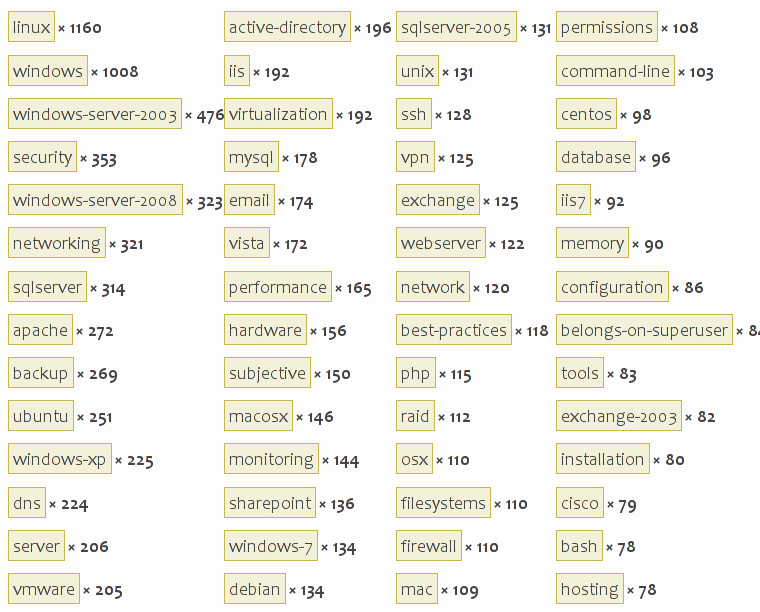
The StackOverflow tags are:
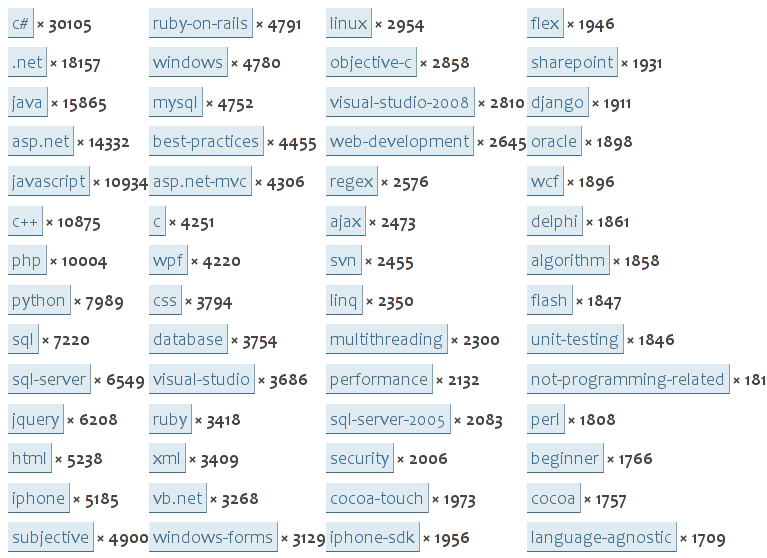
I love to be working, contributing and participating with fabulous people that are advancing the hottest topics of discussion at Stack/Server/Overflow.
Posted on 22 Jul 2009
Popular Topics on StackOverflow
I am probably the last person to find about this, but I find the number of questions/tagged on StackOverflow fascinating:
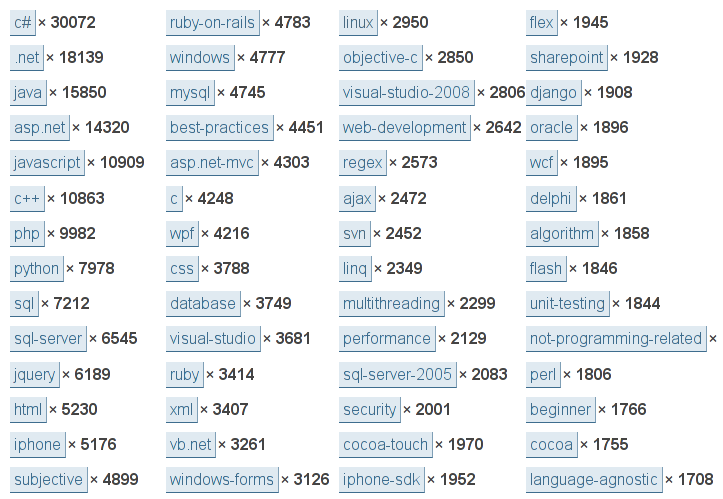
Posted on 21 Jul 2009
TreemapViewer: Building Silverlight Applications on Unix
A few months ago, to get an idea of what contributed to the size of Mono libraries I wrote a small Treemap visualizer using Moonlight:
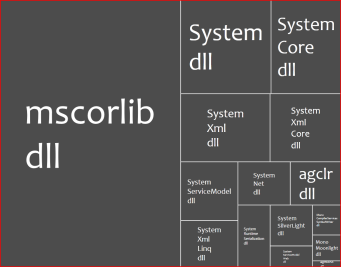
Moonlight's assemblies; area represents the codesize.
You can browser the code or get a copy from our AnonSVN repository.
There are a couple of tools here:
- A tool that extracts the sizes of methods for a collection of assemblies (built using Cecil).
- A
Silverlight control
to render treemaps. The code is based on a paper
on how to do treemaps, and I borrowed a couple of
routines from some code I found for WPF.
A Silverlight-based front-end to host this on the web.
An out-of-browser Gtk#-based front-end to run the application locally.
My Treemap is not very ambitious, and it is nowhere as complete as the new Treemap control that is part of the open source Silverlight Toolkit. But it was a fun learning experience for me.
Reusable Engine
I did not really know where we would use this control, on the web or on the desktop when I started. So I split the actual engine that does the heavy lifting from the actual chrome for the application.
This is why I ended up with a Silverlight user interface and a Gtk# user interface. This idea in general might be useful for other developers as well.
The Custom Control
The custom control is very simple, it is called
TreemapRenderer and derives
from UserControl. The code overwrites two
methods: MeasureOverride
and ArrangeOverride. These methods are used to
allow the control to participate in the Silverlight layout
system (for example, the control can be embedded in a table
that can auto-stretch). Silverlight invokes
your MeasureOverride to find out the desired size
that you control would like to consume:
public class TreemapRenderer : UserControl {
protected override Size MeasureOverride(Size availableSize)
[...]
protected override Size ArrangeOverride(Size finalSize)
[...]
}
Silverlight will invoke your
control's ArrangeOverride to layout its contents
once it has determined the size that the control will use.
This is where my TreemapRenderer lays out its
contents.
This code renders an actual region on the treemap, I like the C# 3.0 initializer syntax for the text created:
public void SetRegion (Rect newRegion)
{
region = newRegion;
content.Children.Clear ();
content.Width = region.Width;
content.Height = region.Height;
if (caption != ""){
int max;
string formatted = MakeCaption (caption, out max);
double w = region.Width * 1.60;
double s = w / max;
var text = new TextBlock () {
FontSize = s,
Text = formatted,
Foreground = new SolidColorBrush (Color.FromArgb (255, 0x5c, 0x5c, 0x5c))
};
Canvas.SetTop (text, (region.Height-text.ActualHeight)/2);
Canvas.SetLeft (text, (region.Width-text.ActualWidth)/2);
content.Children.Add (text);
}
Rect emptyArea = region;
Squarify (emptyArea, root.Children);
Plot (root.Children);
}
To provide feedback to the user, I change the background
color of the treemap on enter/leave. I use anonymous two
anonymous methods, one for MouseEnter, one
for MouseLeave.
Notice that state is shared by these two blocks of code using C# variable capturing. A key feature of the language:
bool inside = false;
host.MouseEnter += delegate {
host.Background = new SolidColorBrush (Colors.Yellow);
if (text != null)
text.Foreground = new SolidColorBrush (Colors.Black);
inside = true;
};
host.MouseLeave += delegate {
host.Background = transparentBrush;
if (text != null)
text.Foreground = borderBrush;
inside = false;
};
One thing that proved very useful was the ability to zoom-into an area. If you click on an assembly, you will get a rendering of the code size used by a type; If you click on that, you get a method breakdown on a class:
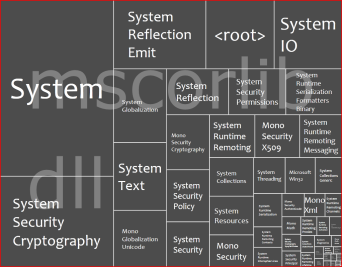
drill-down into mscorlib's sizes.
To transition, I added a cute animation where I render the new image and animate it from the area occupied in the larger view into the final size. This is the code that queues the animation:
// Render a child
void Clicked (Node n)
{
// This is the child rendered, configure it to its final size
TreemapRenderer c = new TreemapRenderer (n, n.Name);
Size ns = new Size(region.Width, region.Height);
c.Measure (ns);
c.Arrange(region);
//
// Scale it and position on the spot that it currently
// occupies on the screen
//
var xlate = new TranslateTransform () {
X = n.Rect.X,
Y = n.Rect.Y };
var scale = new ScaleTransform () {
ScaleX = n.Rect.Width / region.Width,
ScaleY = n.Rect.Height / region.Height };
c.RenderTransform = new TransformGroup { Children = { scale, xlate } };
c.Opacity = 0.5;
content.Children.Add (c);
activeChild = c;
//
// Animate this to its final location
//
TimeSpan time = TimeSpan.FromSeconds (0.3);
var s = new Storyboard () {
Children = {
Animate (time, xlate, "X", 0),
Animate (time, xlate, "Y", 0),
Animate (time, scale, "ScaleX", 1.0),
Animate (time, scale, "ScaleY", 1.0),
Animate (time, c, "Opacity", 1.0),
}};
s.Begin ();
}
// Helper method;
static Timeline Animate (TimeSpan time, DependencyObject target, string path, double to)
{
var animation = new DoubleAnimation () {
Duration = time,
To = to
};
Storyboard.SetTarget (animation, target);
Storyboard.SetTargetProperty (animation, new PropertyPath (path));
return animation;
}
The Silverlight Application
Using the control is fairly simple, but since it loads a large XML files (feel free to change this to use a web service) I use the downloader and a callback to render the control.
private void Application_Startup(object sender, StartupEventArgs e)
{
[...]
var webclient = new WebClient();
webclient.DownloadStringCompleted += delegate (object sender2, DownloadStringCompletedEventArgs ee){
try {
RootVisual.Dispatcher.BeginInvoke(() => LoadNodesFromString(ee.Result));
}
catch (Exception ex) {
main.BackButton.Content = ex.ToString();
}
};
webclient.DownloadStringAsync(new Uri("../mscorlib.xml", UriKind.Relative));
}
The actual creation of the control happens
in LoadNodesFromString:
void LoadNodesFromString(String s)
{
// Use Size for the area.
Node n = LoadNodes(s, "Size", "Extra");
while (n.Children.Count == 1)
n = n.Children[0];
treemap = new TreemapRenderer(n, "");
Grid.SetColumn(treemap, 0);
Grid.SetRow(treemap, 1);
main.grid.Children.Add(treemap);
}
Building a Gtk# Out-of-Browser Client
The above works great for Silverlight, but I like my application on the desktop, so I created a Gtk# version of it.
Moonlight provides a Gtk# widget that can be embedded into C# desktop applications. This is what it looks like when running on the desktop. I know this screenshot is not too exciting as I did not do much with the Gtk+ side of things:
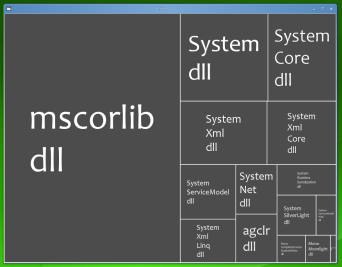
Gtk# is rendering, seriously.
The core of embedding Moonlight as a Gtk# widget is very simple, here it is:
using Moonlight.Gtk;
using Moonlight;
public static void Main(string[] args)
{
n = LoadNodes (args [0], "Size", "Foo");
Gtk.Application.Init ();
MoonlightRuntime.Init ();
// My container window.
Gtk.Window w = new Gtk.Window ("Foo");
w.DeleteEvent += delegate {
Gtk.Application.Quit ();
};
w.SetSizeRequest (width, height);
// The Moonlight widget that will host my UI.
MoonlightHost h = new MoonlightHost ();
// Add Moonlight widget, show window.
w.Add (h);
w.ShowAll ();
// Make it pretty, skip all levels that are just 1 element
while (n.Children.Count == 1)
n = n.Children [0];
// Render
TreemapRenderer r = new TreemapRenderer (n, "");
Size available = new Size (width, height);
r.Measure (available);
r.Arrange (new Rect (0, 0, width, height));
// This informs the widget which widget is the root
h.Application.RootVisual = r;
Gtk.Application.Run ();
}
There are Visual Studio and MonoDevelop solutions on the SVN for folks to try out.
You can also try a sample live on the web.
Posted on 20 Jul 2009
MiggyTour 2009
In the third and fourth weeks of August, Laura and I will be spending a couple of days in Madrid visiting friends.
Then a couple of days hanging out with Nat, Stephanie and a bunch of awesome friends and family friends in Florence.
And then we are spending a week in Morocco, most likely in Marrakesh.
If you live in Madrid or Marrakesh and would like to get together to meet and talk, send me an email.
Posted on 17 Jul 2009
« Newer entries | Older entries »
Blog Search
Archive
- 2024
Apr Jun - 2020
Mar Aug Sep - 2018
Jan Feb Apr May Dec - 2016
Jan Feb Jul Sep - 2014
Jan Apr May Jul Aug Sep Oct Nov Dec - 2012
Feb Mar Apr Aug Sep Oct Nov - 2010
Jan Feb Mar Apr May Jun Jul Aug Sep Oct Nov Dec - 2008
Jan Feb Mar Apr May Jun Jul Aug Sep Oct Nov Dec - 2006
Jan Feb Mar Apr May Jun Jul Aug Sep Oct Nov Dec - 2004
Jan Feb Mar Apr May Jun Jul Aug Sep Oct Nov Dec - 2002
Jan Feb Mar Apr May Jun Jul Aug Sep Oct Dec
- 2022
Apr - 2019
Mar Apr - 2017
Jan Nov Dec - 2015
Jan Jul Aug Sep Oct Dec - 2013
Feb Mar Apr Jun Aug Oct - 2011
Jan Feb Mar Apr May Jun Jul Aug Sep Oct Nov Dec - 2009
Jan Feb Mar Apr May Jun Jul Aug Sep Oct Nov Dec - 2007
Jan Feb Mar Apr May Jun Jul Aug Sep Oct Nov Dec - 2005
Jan Feb Mar Apr May Jun Jul Aug Sep Oct Nov Dec - 2003
Jan Feb Mar Apr Jun Jul Aug Sep Oct Nov Dec - 2001
Apr May Jun Jul Aug Sep Oct Nov Dec